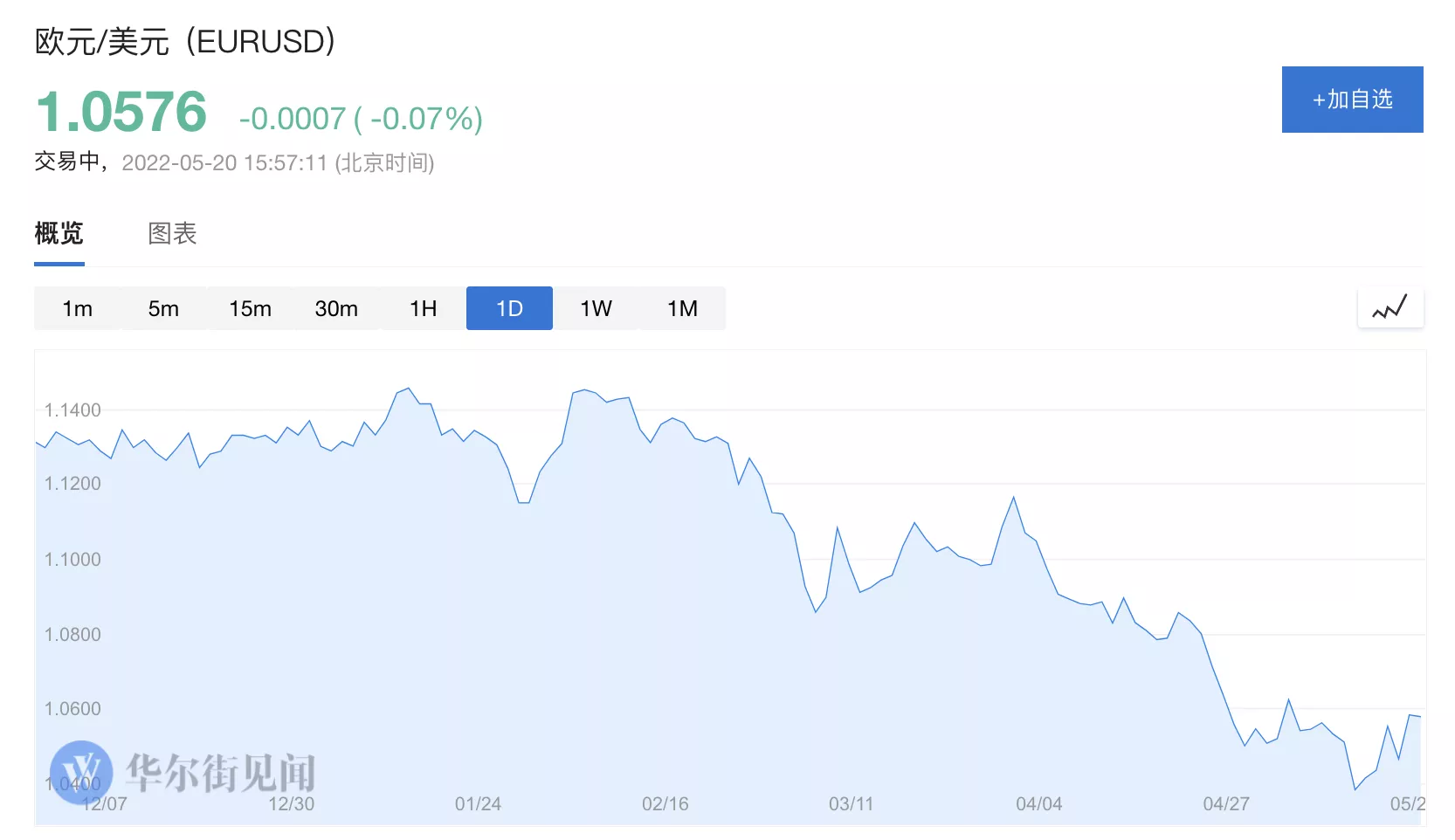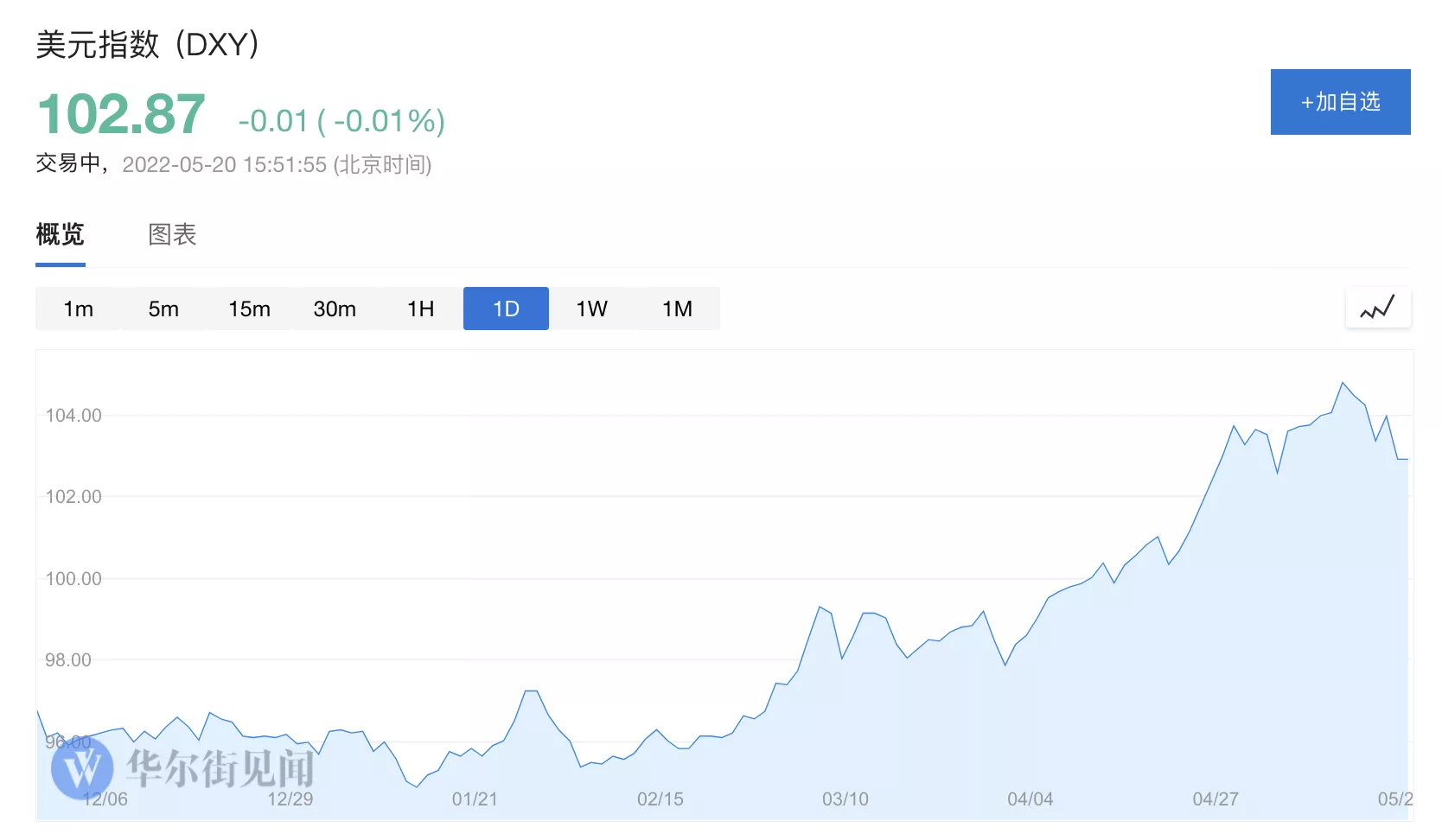Some analysts believe that in order to achieve parity between the euro and the US dollar, it is necessary to reduce the growth expectation of the euro zone relative to the United States, similar to the situation after the conflict between Russia and Ukraine; It is also pointed out that this will require the European Central Bank to maintain "policy inertia" throughout the summer, that is, to keep the interest rate level unchanged.
Since this year, the risk aversion boom caused by market turmoil and the conflict between Russia and Ukraine has led to the influx of funds into the U.S. capital market. The policy deviation between the central banks has also exacerbated the interest rate gap between the United States and the euro zone, boosting the trend of the dollar and the decline of the euro.
So far, the exchange rate of the euro against the US dollar has hovered at about US $1.0576, down steadily from about US $1.22 in June last year. Earlier this week, the euro even fell to a level slightly higher than the euro to US $1.03.

This is the first time that the euro is close to parity against the US dollar in 20 years, and some hedge funds have already bet on it.
In the past month, traders have bet heavily on the parity of the euro against the US dollar through foreign exchange options, and put options betting heavily on the euro have become the most popular foreign exchange derivatives.
Francesco pesole, currency strategist at ing groep NV, said the euro itself was not attractive at the moment. He also acknowledged that the strength of the US dollar and market volatility mean that the euro may eventually reach parity against the US dollar.
But monetary strategists remain divided over whether the euro and the dollar will eventually fall to parity, what this will mean for investors and the global economy, and whether this trend will continue.
Why is it close to parity
First, investors turned to traditional safe haven assets due to concerns about the conflict in Ukraine, soaring inflation, supply chain problems, slowing economic growth and tightening monetary policy, and the US dollar strengthened driven by risk aversion.
Secondly, the narrowing of the gap between the two currencies is also caused by the differences of central banks on monetary policy. The Fed raised its benchmark interest rate by 50 basis points earlier this month for the second time this year to control inflation at a 40 year high.
Fed chairman Powell said on Tuesday that the Fed would not hesitate to continue to raise interest rates until inflation fell to a controllable level, and reiterated its commitment to bring inflation closer to the Fed's target of 2%.
In sharp contrast to the Federal Reserve and the Bank of England, the European Central Bank has not yet raised interest rates despite record inflation in the eurozone.
A week ago, according to the financial times, Vincent Mortier, chief investment officer of amundi, Europe's largest asset management company, predicted that the European Central Bank would give priority to controlling the government's borrowing costs rather than fighting inflation. This decision will make the European Central Bank further lag behind the Federal Reserve in fighting inflation and raising interest rates. The market also overestimated the ECB's ability to raise interest rates because of concerns about the economic recession and rising borrowing costs in some member states with a heavy debt burden in the eurozone.
However, the European Central Bank has hinted that it will end its asset purchase program, and policymakers have been more hawkish recently.
Under what circumstances will parity really be achieved
On Wednesday, Sam zief, global head of foreign exchange strategy at JPMorgan Chase private bank, said in an interview with CNBC that in order to achieve parity between the euro and the US dollar, it is necessary to "reduce the growth expectation of the euro zone relative to the United States, similar to our situation after the conflict between Russia and Ukraine."
Zief said:
Is this possible? Of course, but this is certainly not our basic situation. Even so, the parity between the euro and the US dollar will be the worst case.
The European Central Bank is likely to get out of the negative interest rate zone and the outflow of fixed income funds from the eurozone is reduced - which means that the euro now looks "incredibly cheap". I don't think many customers will think that buying euros at an exchange rate below $1.05 is a bad idea when they look back two to three years later.
He pointed out that the Fed's aggressive interest rate hike cycle and quantitative tightening policy in the next two years have been reflected in the US dollar, and Stephen Gallo, head of European foreign exchange strategy at BMO capital markets, also agreed with this view.
Gallo told CNBC by email that it was not just the prospect of major policy differences between the Federal Reserve and the European central bank that affected the exchange rate of the euro against the dollar.
This is also the possibility that the euro's core energy flow will weaken in the future.
According to the data we tracked, we did not see any sign that leveraged funds significantly increased their short positions in the euro against the US dollar, which led us to believe that the weakness of the euro was due to the potential deterioration of core liquidity.
Gallo believes that in order to achieve parity between the euro and the US dollar, the European Central Bank will need to maintain "policy inertia" throughout the summer, that is, keep the interest rate unchanged, and Germany will completely ban the import of fossil fuels from Russia, which will bring about the energy rationing system.
At present, the economic outlook of Europe is not optimistic. On the issue of supplying natural gas to the European continent, Russia and EU countries continue to confront each other, which increases the possibility of interruption of natural gas supply. The International Monetary Fund has lowered its economic growth forecast for the eurozone in 2022 to 2.8%.
"If the ECB faces the worst-case scenario of an increase in the risk of recession in Germany and a further sharp rise in prices (i.e. terrible economic stagnation), it is not surprising that ECB policy continues to maintain inertia," Gallo said.
The euro may weaken further
Although many analysts are still skeptical about whether the euro will fall to parity with the US dollar, some market participants still believe that the euro will weaken further.
After the meeting of the Federal Reserve in June 2021, the interest rate difference relative to the United States had an impact on the euro. At that meeting, Federal Reserve officials issued an increasingly active pace of policy tightening.
Jonas goltermann, senior market economist at Kaitou macro capital economics, said in a report last week that the recent hawkish transformation of the European Central Bank still lags behind the Fed and is not enough to offset the rise in inflation expectations in the eurozone since the beginning of 2022.
Kaitou macro expects that the Fed's policy path will be similar to that reflected by the market, but goltermann expects that the ECB's policy path will not be as radical as expected, which means that the nominal interest rate spread between the eurozone and the United States will change further, but the range of change will be much smaller than that in June last year.
The deterioration of the terms of trade in the euro area, the slowdown of the global economy and the intensification of future turmoil, and the vulnerability of the bond markets of peripheral countries in the euro area make the euro more vulnerable to fiscal austerity, which further exacerbates the view that the euro is weakening.
Goltermann said:
As a result, contrary to most other analysts, we expect the euro to weaken further against the dollar.
We expect the euro / US dollar exchange rate to reach parity later this year and then rebound to US $1.10 in 2023, as the adverse factors for the eurozone economy will ease and the Fed's tightening cycle will end.
Francois Villeroy de galhau, a policy maker of the European Central Bank, said on Monday that the excessive weakness of the euro threatened the price stability of the eurozone, increased the cost of imports and commodities denominated in dollars, and further exacerbated the already high price pressure in the eurozone.
The dollar is now "the most expensive currency in the world"
Since the beginning of the year, the dollar index has risen by about 8%. Deutsche Bank said in a report on Tuesday that the "safe haven" risk premium of the US dollar has reached an "extreme ceiling" even taking into account the interest rate difference.

George saravelos, CO head of global foreign exchange research at Deutsche Bank, believes that a turning point is coming. He pointed out that we are now at a stage where the further deterioration of the financial situation "weakens the Fed's tightening expectations", while the rest of the world, especially Europe, will still tighten policies significantly.
Saravelos said:
We do not think that Europe is about to enter an economic recession. Contrary to the general view of the market, European economic data will continue to be better than that of the United States.
Deutsche Bank's valuation monitoring shows that the US dollar is now "the most expensive currency in the world", and its foreign exchange position index shows that the long position of the US dollar against emerging market currencies has reached the highest level since the peak of the epidemic.
Saravelos concludes:
All this sends the same message: dollars are too expensive. Our forecasts suggest that the euro will return to $1.10 against the dollar in the coming months, rather than falling to parity.
Gallo also pointed out that for the role of the Federal Reserve in all this, he believed that the Federal Reserve would be shocked by the trend of the euro against the US dollar in the range of 0.98-1.02 US dollars and the strength of the US dollar. "I can foresee that this trend of the euro against the US dollar will cause the Federal Reserve to suspend or slow down its tightening pace."